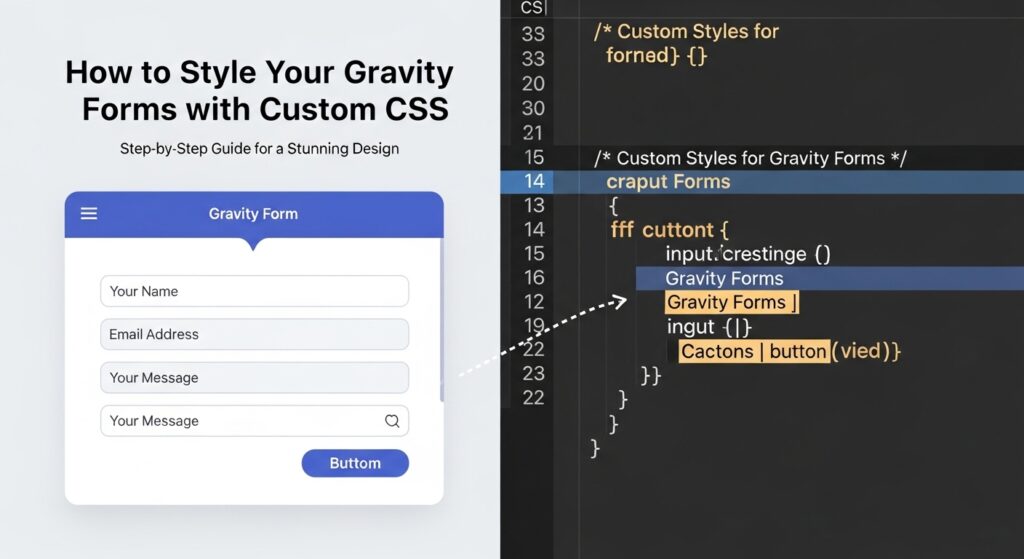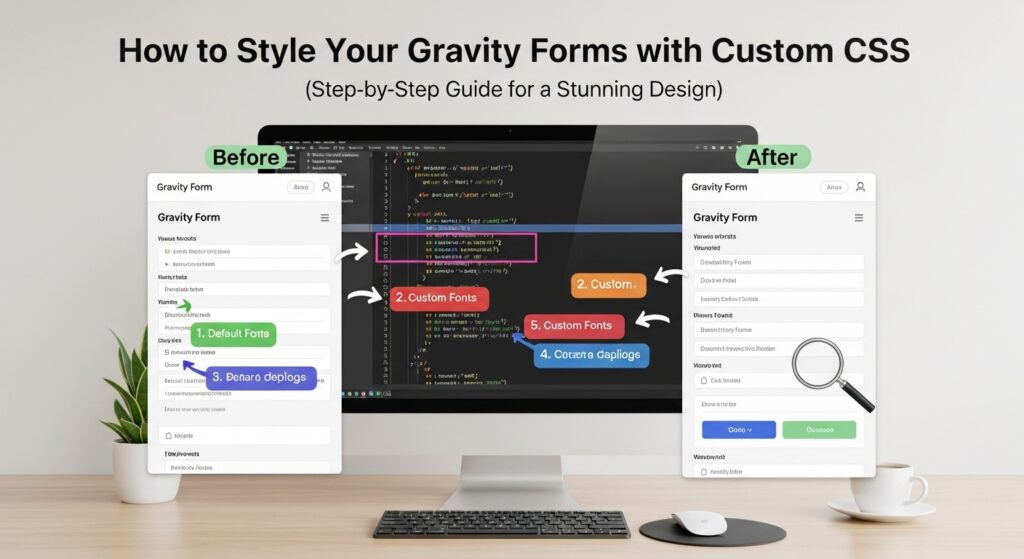Introduction: Why Your Gravity Forms Deserve a Makeover
Imagine this: a visitor lands on your beautifully designed website, scrolls through your compelling content, and finally reaches your contact form — only to find a bland, default-looking form that ruins the aesthetic harmony.
That’s the silent killer of conversions!
In digital marketing and user experience design, first impressions matter. A well-styled form doesn’t just collect data — it reflects your brand identity, improves user engagement, and drives higher conversion rates.
This is why learning how to style your Gravity Forms with custom CSS is one of the most underrated skills every WordPress user should master.
In this EduKester guide, you’ll discover step-by-step how to customize your Gravity Forms with CSS, including pro design tips, color strategies, and real-world examples that make your forms stand out like a polished diamond on your website.
🧩 What Are Gravity Forms? (And Why Marketers Love Them)
Gravity Forms is one of the most powerful form builder plugins for WordPress. It allows you to create everything from simple contact forms to complex multi-step applications, surveys, and payment forms — without writing a single line of code.
But the beauty of Gravity Forms lies not just in its functionality — it’s in its flexibility. You can style every element of your form to match your website’s branding using custom CSS.
💡 Pro Insight: According to Form Conversion Reports, well-styled forms improve completion rates by up to 35% compared to generic ones.

🎨 Why Use Custom CSS for Gravity Forms?
Although Gravity Forms includes some basic styling options, these are often not enough for unique brand customization. That’s where CSS (Cascading Style Sheets) comes in — it gives you full control over layout, typography, colors, and spacing.
Here are key benefits:
✅ Brand Consistency: Match your forms with your website’s theme colors and fonts.
✅ Improved Readability: Better spacing and contrast help users fill out forms easily.
✅ Enhanced User Experience: Stylish, intuitive forms increase conversions.
✅ Mobile Optimization: You can tweak padding and sizing for responsiveness.
✅ Professional Edge: Custom styling makes your forms look like part of your design — not an afterthought.
🧠 Understanding Gravity Forms CSS Structure
Before styling, it’s crucial to understand Gravity Forms’ basic CSS structure. Each form element has a specific CSS class, such as:
| Element | CSS Class | Description |
|---|---|---|
| Form Wrapper | .gform_wrapper | The main container of the form |
| Form Fields | .gfield | Each individual field |
| Labels | .gfield_label | The text label for each input |
| Input Fields | .medium, .large, .small | Field size classes |
| Buttons | .gform_button | Submit button styling |
| Error Messages | .validation_message | Form validation alerts |
🧭 Tip: Use your browser’s Inspect Tool (Right-click → Inspect) to identify and test styles live before applying them permanently.
⚙️ How to Add Custom CSS to Gravity Forms (3 Easy Methods)
Method 1: Add CSS via WordPress Customizer
- Go to Appearance → Customize → Additional CSS.
- Paste your custom CSS code.
- Click Publish to save changes.
Example:
body .gform_wrapper .gfield_label {
font-weight: 600;
color: #1a1a1a;
font-size: 16px;
}
Method 2: Add CSS via Your Theme’s Stylesheet
You can add styles in your theme’s style.css file (or via a child theme).
Example:
.gform_wrapper input[type="text"],
.gform_wrapper textarea {
border-radius: 10px;
border: 1px solid #ccc;
padding: 12px;
width: 100%;
font-size: 15px;
transition: border-color 0.3s ease;
}
.gform_wrapper input[type="text"]:focus {
border-color: #0073e6;
outline: none;
}
This approach keeps your styles permanent — even if the plugin updates.
Method 3: Use a Custom CSS Plugin
If you don’t want to edit files directly, install a plugin like Simple Custom CSS or WP Add Custom CSS.
Then, target specific forms using the form ID:
Example:
body #gform_wrapper_1 {
background: #f9f9f9;
padding: 20px;
border-radius: 15px;
box-shadow: 0 0 10px rgba(0,0,0,0.1);
}
🪄 Pro Tip: You can target individual forms using their unique ID —
#gform_wrapper_1for Form 1,#gform_wrapper_2for Form 2, and so on.
💡 Gravity Forms Styling Examples (Copy + Paste Templates)
1. Minimalist Form Design
.gform_wrapper .gfield_label { display: none; }
.gform_wrapper input,
.gform_wrapper textarea {
border: none;
border-bottom: 2px solid #ddd;
background: transparent;
width: 100%;
padding: 8px;
}
.gform_wrapper .gform_button {
background-color: #000;
color: #fff;
border: none;
padding: 12px 25px;
border-radius: 5px;
}
🖼️ Visual Inspiration:
2. Modern Gradient Button Style
.gform_wrapper .gform_button {
background: linear-gradient(90deg, #ff7e5f, #feb47b);
color: white;
font-weight: bold;
text-transform: uppercase;
border: none;
border-radius: 30px;
padding: 12px 35px;
transition: all 0.3s ease;
}
.gform_wrapper .gform_button:hover {
background: linear-gradient(90deg, #feb47b, #ff7e5f);
}
📸 Infographic Idea: A “before vs after” visual showing a default Gravity Form versus a custom CSS-enhanced one.
3. Floating Label Effect
.gform_wrapper .gfield input:focus + label,
.gform_wrapper .gfield textarea:focus + label {
transform: translateY(-20px);
font-size: 12px;
color: #0073e6;
}
This trendy design creates a sleek, app-like form experience.
📊 Pro Design Tips for Better Gravity Form UX
✅ Use ample white space: Don’t clutter — let each field breathe.
✅ Highlight active fields: Use subtle animations to show focus states.
✅ Color psychology: Use brand-aligned colors that build trust (e.g., blue for reliability, green for growth).
✅ Consistency: Keep button styles consistent across your website.
✅ Mobile-first approach: Test your forms on multiple devices.
📈 Fact: Google’s UX Report shows mobile-friendly forms can boost submission rates by up to 27%.
🔧 Bonus: Using Gravity Forms CSS Ready Classes
Gravity Forms includes ready classes you can add directly within the form editor:
| Ready Class | Purpose |
|---|---|
gf_left_half | Places field on the left half |
gf_right_half | Places field on the right half |
gf_inline | Displays fields inline |
gf_list_inline | Displays checkboxes inline |
👉 Add these in the Field Settings → Appearance → Custom CSS Class box to instantly change layouts — no coding needed!
🧰 Troubleshooting Common CSS Issues
If your custom styles don’t apply:
- Clear your website cache (especially if using caching plugins).
- Use specific selectors to override plugin defaults.
- Add
!importantfor stubborn rules. - Make sure your theme doesn’t have conflicting CSS.
Example:
.gform_wrapper .gform_button {
background-color: #000 !important;
}
🧠 Advanced Option: Targeting Conditional Logic and Multi-Page Forms
For multi-step or conditional forms, use these classes:
| Element | CSS Class |
|---|---|
| Progress Bar | .gf_progressbar |
| Active Page | .gf_page_active |
| Next/Previous Buttons | .gform_next_button, .gform_previous_button |
Example:
.gform_wrapper .gf_progressbar {
height: 8px;
background-color: #e0e0e0;
border-radius: 10px;
}
.gform_wrapper .gf_progressbar_percentage {
background-color: #00b894;
border-radius: 10px;
}
🖼️ Infographic Idea: Show a visual of a styled multi-step Gravity Form with progress tracking.

❓ FAQs: Styling Gravity Forms with Custom CSS
Q1. Can I use page builders like Elementor with Gravity Forms?
Yes! Gravity Forms integrates seamlessly with Elementor and other builders — you can style them using both visual controls and CSS.
Q2. Will updates break my custom CSS?
Not if you use a child theme or a custom CSS plugin. Avoid editing plugin core files.
Q3. Can I use Google Fonts or custom typography?
Absolutely. Import Google Fonts in your theme or CSS file and apply them to your form elements.
Q4. What’s the best font size for readability?
Typically, 15–17px works best for input text, with 16–18px for labels.
Q5. Is there a CSS framework for Gravity Forms?
Yes, you can integrate frameworks like Bootstrap or Tailwind CSS, but ensure you override default Gravity Forms classes properly.
✨ Conclusion: Transform Your Forms, Transform Your Brand
Your form isn’t just a data collection tool — it’s a conversion engine.
With a few lines of custom CSS, you can turn a dull Gravity Form into a sleek, professional, and brand-aligned masterpiece that users enjoy filling out.
As EduKester always says:
💬 “Design is not just what it looks like — it’s how it works.”
So go ahead — experiment, test, and style your Gravity Forms with confidence. Make every form a reflection of your creativity and brand excellence.
📝 Notes
Meta Description:
Learn how to style your Gravity Forms with custom CSS. Step-by-step guide with examples, visuals, and pro tips to design stunning, brand-aligned forms that convert.
Tags:
Gravity Forms, WordPress Forms, Custom CSS, Web Design, UX Optimization, CSS Styling, Form Design, WordPress Tips, EduKester, UI Enhancement
Long-Tail Keywords:
- How to style Gravity Forms with CSS
- Gravity Forms custom CSS examples
- Gravity Forms design tutorial
- Best CSS for WordPress forms
- Customize Gravity Forms’ appearance
Would you like me to design the infographics and visuals (with your brand “EduKester”) for this post next? I can generate high-quality images for:
- “Before vs After Form Design”
- “CSS Structure of Gravity Forms”
- “3-Step Styling Process”
- “Mobile-Friendly Form Layout Example.”



